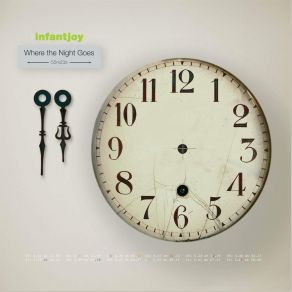Where the Night Goes
Download links and information about Where the Night Goes by Infantjoy. This album was released in 2005 and it belongs to Ambient, Electronica, Rock, Alternative genres. It contains 12 tracks with total duration of 57:44 minutes.

|
|
|---|---|
| Artist: | Infantjoy |
| Release date: | 2005 |
| Genre: | Ambient, Electronica, Rock, Alternative |
| Tracks: | 12 |
| Duration: | 57:44 |
| Buy it NOW at: | |
| Buy on iTunes $9.99 | |
Tracks
[Edit]| No. | Title | Length |
|---|---|---|
| 1. | Departure | 4:32 |
| 2. | Just Before Midnight | 4:52 |
| 3. | Nightshade | 4:28 |
| 4. | Someone Was Saying | 6:48 |
| 5. | Composure | 6:25 |
| 6. | Ghosts | 4:46 |
| 7. | Application 1 | 4:22 |
| 8. | Application 2 | 3:19 |
| 9. | Application 3 | 3:47 |
| 10. | Nearing the Sun | 5:56 |
| 11. | Vexuality | 5:01 |
| 12. | Arrival | 3:28 |
Details
[Edit]Infantjoy is an unexpected but apt collaboration between James Banbury and Paul Morley. Banbury, a multi-instrumentalist, has long been a Luke Haines associate, going back to the first Auteurs album, and has logged studio time with several other musicians. Morley, a journalist and author, was behind a lot of the concepts and some of the sounds that came from the ZTT label during the mid-'80s; the last time he was seen doing something musical was in the late '90s, when he was holding a microphone and a sledgehammer on-stage with the rest of a reconvened Art of Noise, who were supporting The Seduction of Claude Debussy. The steady Where the Night Goes could be seen as a follow-up to that uneven album, even though Morley is the lone common factor and Banbury supplies the music. This disc takes inspiration from another composer, Erik Satie, who is credited with "Haunting, etc," and he is felt throughout here as much as Debussy was on the Art of Noise album, albeit in a slightly more concealed way, from the echoing piano notes and the spaces between them to the deeply conceptualized nature of the whole thing. Predominantly instrumental, Where the Night Goes is an ambient album that functions equally well in the foreground and the background. It remains intensely rhythmic when the tempos are slow and the beats are nonexistent, creating its own world while occasionally hinting at other things from the past. "Composure"'s insistent stateliness could spiral off into Manuel Göttsching's "E2-E4" or Kraftwerk's "Trans-Europe Express." Before "Nearing the Sun" works itself into a series of noisy collisions between all of its elements, its cold crunching beat resembles early Boards of Canada. An appropriate cover of Japan's "Ghosts," featuring the frosty comfort of Black Box Recorder's Sarah Nixey, is right in the middle of the album; it's neither as startling nor as stark as the original, but its twinkling jack-in-the-box melody, flickering noise fragments, and droning/drifting strings give the song a new angle that also happens to discreetly slip into the album's scheme. (Japan themselves were haunted by Satie.) Morley's text in the booklet is a helpful guide and can fill your head with thoughts and ideas as you listen, but you needn't read it — or know anything about Satie, Banbury, or Morley — to enjoy the trip.